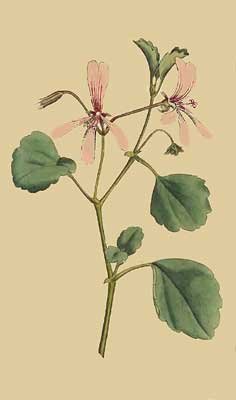Pelargonium Acetosum
Flowers

Pelargonium Acetosum
Mons. LHeritier, the celebrated French Botanist, who in the number, elegance, and accuracy of his engravings, appears ambitious of excelling all his contemporaries, in a work now executing on the family of Geranium, has thought it necessary to divide that numerous genus into three, viz. Erodium, Pelargonium, and Geranium.The Erodium includes those which Linnaeus (who noticing the great difference in their appearance, had made three divisions of them) describes with five fertile stamina, and calls Myrrhina, the Pelargonium those with seven fertile stamina, his Africana, the Geranium, those with ten fertile stamina, his Batrachia.They are continued under the class Monadelphia, in which they now form three different orders, according to the number of their stamina, viz. Pentandria, Heptandria, and Decandria. If the principles of the Linnaean system had been strictly adhered to, they should perhaps have been separated into different classes, for though the Pelargonium is Monadelphous, the Geranium is not so, in consequence of this alteration, the Geranium peltatum and radula, figured in a former part of this work, must now be called Pelargonium peltatum, and radula, and the Geranium Reichardi be an Erodium.The leaves of this plant have somewhat the taste of sorrel, whence its name, it flowers during most of the summer, and is readily propagated by cuttings. Miller mentions a variety of it with scarlet flowers.It is a native of the Cape, and known to have been cultivated in Chelsea Garden, in the year 1724.
 Ixora Coccinea
Ixora Coccinea Alyssum Utriculatum
Alyssum Utriculatum Plumbago Rosea
Plumbago Rosea Cineraria Lanata
Cineraria Lanata Lysimachia Bulbifera
Lysimachia Bulbifera Limodorum Tuberosum
Limodorum Tuberosum Lupinus Luteus
Lupinus Luteus Strelitzia Reginae
Strelitzia Reginae Narcissus Biflorus
Narcissus Biflorus Lathyrus Tuberosus
Lathyrus Tuberosus Monarda Fistulosa
Monarda Fistulosa Hibiscus Rosa Sinensis
Hibiscus Rosa Sinensis Test your English Language
Test your English Language  Festivals of India
Festivals of India Tips for Best Student in the class
Tips for Best Student in the class Interior Essentials
Interior Essentials Benefits of Apricots
Benefits of Apricots Benefits of Guava
Benefits of Guava Most Popular Search Engines
Most Popular Search Engines Intriguing Lost Cities Around the World
Intriguing Lost Cities Around the World Benefits of Cucumber
Benefits of Cucumber Benefits of Cashew
Benefits of Cashew




